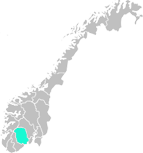



The sun mirror in Rjukan
The founder of the town Rjukan, mr Sam Eyde, launched the idea in 1913 of a “Solspeil”, or sun mirror, above Rjukan. He saw the importance of the “sun in Rjukan” as well in the winter. He also had a need to give his workers the opportunities for sunlight in the winter. This idea is one of the few Sam Eyde did not manage to follow through to completion.
Instead, his successors built a gondola in 1928 to transport Rjukan´s inhabitants to the winter sunshine. This gondola was called Krossobanen. The gondola is currently out of order.
Today´s technology has made an idea that was first conceived in 1913 possible: to deliver the sun to the people of Rjukan.
The idea was taken up again in 2005 by Martin Andersen, an artist and resident of the town. In 2013 the mirror was officially opened, - 100 years after the idea.
A computer-driven heliostat, placed at the top of steep mountain wall over the town square captures the sun´s rays and direct them into Rjukan´s square. The three heliostats consist of computer-driven mirrors that follow the suns movement over the horizon and reflects its rays into Rjukan´s market square.
Technical specifications
The sun mirror is installed on the mountain wall at 742 metres over sea level, about 450 metres above the Rjukan market square. Each mirror is 17 metres in area, or together 51m2.
The mirrors captures the sunlight and send it into the market square, where it has an ellipse shape of about 600 m2. The reflected light has between 80 and 100% of the effect compared to the light that is captured by the mirrors.
Rjukan
Deep in the narrow Vestfjord valley in Telemark, surrounded by steep mountains, at the foot of the mighty Gaustatoppen mountain, lies the industrial town of Rjukan.
Rjukan is the home of a thriving small community which manages without the sun for almost six months of the year. The town lies at the bottom of a valley that is oriented east to west, with Gaustatoppen (at 1883 metres over sea level) and the other surrounding mountains immediately south of the town rendering the city sun free from September to March.
The town was created by Norwegian industry – the hydro story being central to its inception. Rjukan was built by Hydro´s founder Sam Eyde at the beginning of the last century. The town was planned with the best architects and engineers of the time, by Norsk Hydro – a so-called “company town”.




The mountain Gaustatoppen in Rjukan in Telemark county is easily accessable and one of…
At the Norwegian Industrial Workers Museum at Vemork you can see the unique exhibition…
Vieving stones.
Eight different sculptured "vieving stones" have been placed in to the…
Gallery Nutheim was opened in 1978. The Gallery exhibits art by local artists. Nutheim…
Vieving stones.
Eight different sculptured "vieving stones" have been placed in to the…
Vieving stones.
Eight different sculptured "vieving stones" have been placed in to the…
Vieving stones.
Eight different sculptured "vieving stones" have been placed in to the…
The museum shows sculptures, paintings, graphic art and drawings by the famous artist…
The Skinnarland Collection houses more than 100 works of art by sculptor Knut Skinnarland…
Raulandsakademiet is a course center, a hostel and a rural museum.
A collection of replicas of local traditional log buildings, filled with cultural…
Vieving stones.
Eight different sculptured "vieving stones" have been placed in to the…
Vieving stones.
Eight different sculptured "vieving stones" have been placed in to the…
Vieving stones.
Eight different sculptured "vieving stones" have been placed in to the…